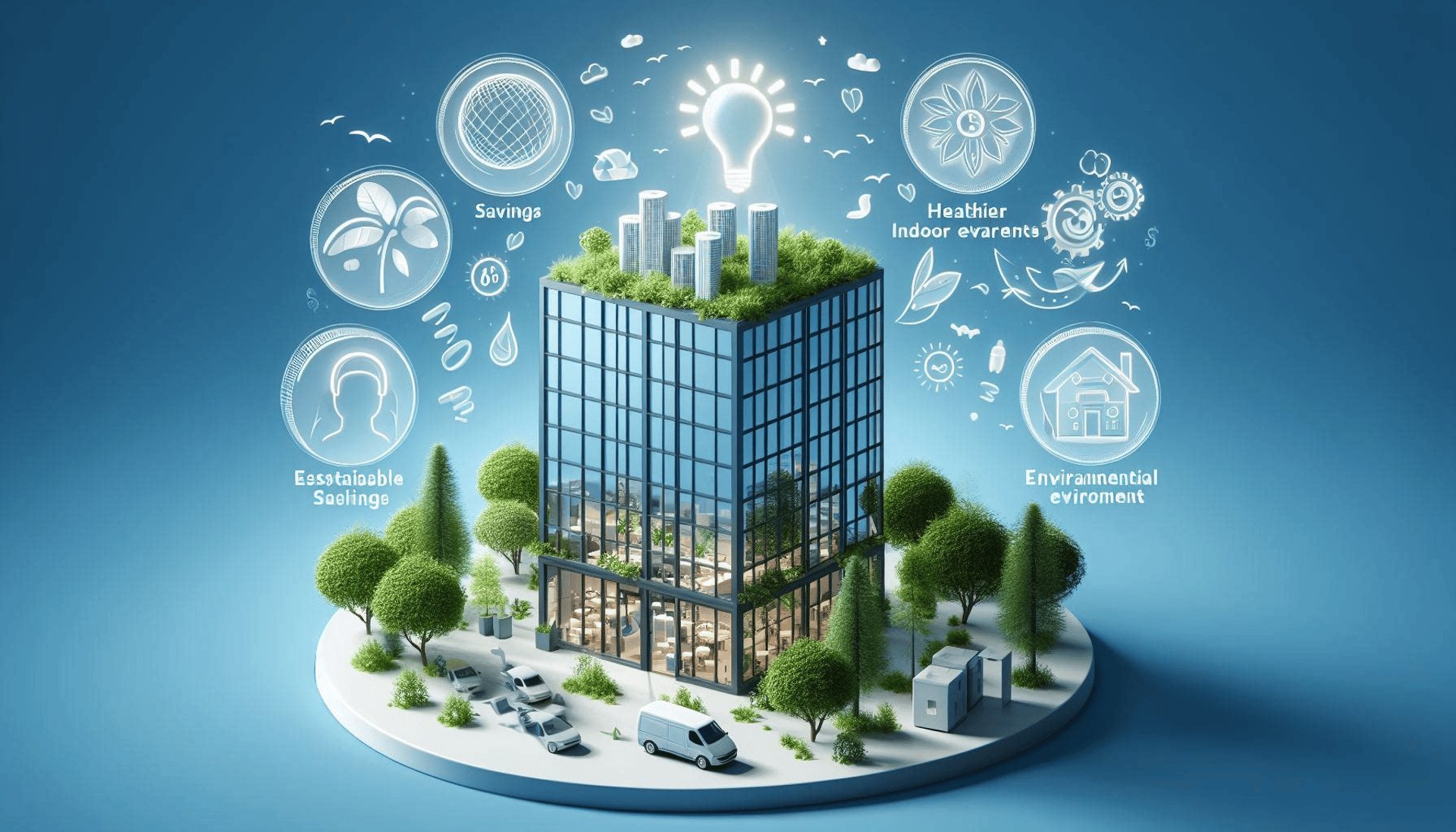
Designing for the Future: The Benefits of Sustainable Commercial Spaces
Sustainable Design Principles for Commercial Spaces unlock energy savings, healthier indoor environments, and reduced environmental impact, fostering a greener future.
ARCHITECTURE


Designing for the Future: The Benefits of Sustainable Commercial Spaces
In today's era of heightened environmental consciousness, the importance of sustainable design principles for commercial spaces cannot be overstated. As a professional copywriting journalist, I'm often asked: How can businesses and organizations leverage sustainable design to create more eco-friendly, energy-efficient, and employee-centric workspaces? This is a crucial question that deserves our attention.
As businesses and organizations increasingly prioritize environmental sustainability, the demand for sustainable commercial spaces has grown significantly. Sustainable design principles for commercial spaces offer a range of benefits, including reduced energy consumption, improved indoor air quality, and a smaller carbon footprint. By embracing these principles, companies can not only contribute to a greener future but also reap tangible advantages that positively impact their operations, employees, and the environment.
Key Takeaways:
Sustainable design principles for commercial spaces can lead to reduced energy consumption and a smaller carbon footprint.
Incorporating biophilic design concepts and energy-efficient architecture can enhance indoor environmental quality and employee well-being.
The pursuit of net-zero energy buildings represents a cutting-edge approach to sustainable commercial design.
Selecting sustainable materials and conducting life cycle assessments can minimize the environmental impact of commercial spaces.
Achieving LEED certification demonstrates a commitment to sustainability and green building strategies.
Sustainable Design Principles for Commercial Spaces
As businesses and organizations strive to reduce their environmental impact, sustainable design principles for commercial spaces have gained significant traction. These principles encompass a range of strategies and technologies aimed at creating energy-efficient, eco-friendly, and environmentally responsible buildings.
Energy-Efficient Architecture
At the core of sustainable commercial design lies the concept of energy-efficient architecture. This approach focuses on optimizing building orientation, enhancing insulation, and incorporating passive solar design techniques to minimize energy consumption. By leveraging these strategies, commercial spaces can significantly reduce their energy demands, leading to cost savings and a smaller carbon footprint.
Biophilic Design Concepts
Biophilic design concepts, which integrate natural elements and views into the built environment, have also gained traction in sustainable commercial design. These principles aim to create a connection between the indoor and outdoor spaces, enhancing the indoor environmental quality and promoting the well-being of building occupants. Through the incorporation of greenery, natural materials, and strategic daylighting, biophilic design can foster a more nurturing and productive work environment.
Net-Zero Energy Buildings
Taking sustainable commercial design to the next level, the pursuit of net-zero energy buildings represents a cutting-edge approach. These innovative structures are designed to generate as much renewable energy as they consume, effectively minimizing their reliance on traditional energy sources and reducing their overall carbon footprint. By embracing this concept, commercial spaces can demonstrate a strong commitment to environmental stewardship and set a new standard for sustainable development.
Sustainable Materials Selection
As businesses prioritize environmental responsibility, the selection of sustainable materials has become a crucial aspect of designing commercial spaces. By conducting a life cycle assessment, which evaluates the environmental impact of a material throughout its entire lifespan, designers can make informed decisions about the use of eco-friendly materials that have a minimal carbon footprint.
Life Cycle Assessment
The life cycle assessment process involves analyzing the various stages of a material's life, from extraction and manufacturing to transportation, usage, and eventual disposal or recycling. This comprehensive approach allows designers to identify the most sustainable options that not only reduce waste and conserve natural resources but also minimize the overall environmental impact of the commercial space.
Eco-Friendly Materials
The range of eco-friendly materials available for commercial spaces continues to expand, offering designers a wealth of options to choose from. These materials may include renewable resources, such as bamboo and cork, which are known for their durability and low environmental impact. Additionally, recycled and recyclable products, such as those made from reclaimed wood or recycled plastics, can further contribute to the sustainability of the design.
By carefully considering sustainable materials selection and incorporating life cycle assessment into the design process, commercial spaces can be transformed into eco-friendly, energy-efficient, and environmentally responsible environments that benefit both the occupants and the planet.
Indoor Environmental Quality
Sustainable design principles for commercial spaces place a strong emphasis on enhancing the indoor environmental quality, which can have a significant impact on the health, productivity, and well-being of building occupants. By incorporating strategies that prioritize improved air quality and natural lighting, businesses can create spaces that promote the overall comfort and well-being of their employees.
Improved Air Quality
Improving indoor air quality is a crucial aspect of sustainable commercial design. This can be achieved through the implementation of advanced ventilation systems that effectively circulate and filter the air, as well as the selection of low-emitting materials that minimize the release of volatile organic compounds (VOCs) and other pollutants. By ensuring a clean and healthy indoor environment, businesses can contribute to the improved air quality that employees breathe, leading to enhanced productivity and reduced absenteeism.
Natural Lighting Strategies
Incorporating natural lighting strategies into the design of commercial spaces is another key component of sustainable design. By maximizing the use of natural daylight through the strategic placement of windows, skylights, and other architectural features, businesses can reduce their reliance on artificial lighting and tap into the numerous benefits of natural illumination. This not only helps to lower energy consumption but also promotes the circadian rhythms of employees, leading to improved mood, focus, and overall well-being.
Benefits of Improved Indoor Environmental QualityStrategies for Enhancing Indoor Environmental Quality
Increased employee productivity and well-being
Reduced absenteeism and sick leave
Improved air quality and thermal comfort
Enhanced natural lighting and access to daylight
Reduced energy consumption and environmental impact
Implementing advanced ventilation systems
Selecting low-emitting materials and finishes
Maximizing natural daylight through strategic design
Incorporating operable windows and shading devices
Integrating biophilic design elements
Reducing Carbon Footprint
Sustainable design principles for commercial spaces also focus on reducing the overall carbon footprint of the building, which is crucial for mitigating the effects of climate change. This can be achieved through the implementation of green building strategies, such as the use of energy-efficient systems and the incorporation of renewable energy sources.
Green Building Strategies
Green building strategies encompass a range of techniques and technologies aimed at minimizing the environmental impact of commercial spaces. This includes the use of energy-efficient HVAC systems, LED lighting, and advanced insulation materials to reduce energy consumption and lower greenhouse gas emissions. By adopting these strategies, businesses can significantly reduce their carbon footprint and contribute to a more sustainable future.
LEED Certification
Another key aspect of reducing the carbon footprint of commercial spaces is the pursuit of LEED (Leadership in Energy and Environmental Design) certification. This globally recognized standard for sustainable construction and operation provides a comprehensive framework for designing, building, and operating environmentally-responsible buildings. By achieving LEED certification, commercial spaces can demonstrate their commitment to sustainability and their dedication to minimizing their environmental impact.
Renewable Energy Sources
The integration of renewable energy sources, such as solar panels and wind turbines, is a crucial component of reducing the carbon footprint of commercial spaces. By generating their own clean energy, businesses can reduce their reliance on fossil fuels and further contribute to the fight against climate change. The adoption of renewable energy solutions not only benefits the environment but also presents opportunities for cost savings and enhanced energy resilience.
Conclusion
In conclusion, the adoption of sustainable design principles for commercial spaces offers a comprehensive approach to creating environmentally-responsible and energy-efficient buildings. By incorporating strategies such as energy-efficient architecture, biophilic design concepts, and the use of sustainable materials, businesses and organizations can not only reduce their carbon footprint but also enhance the indoor environmental quality and overall well-being of their employees.
Additionally, the pursuit of LEED certification and the integration of renewable energy sources further demonstrate a commitment to sustainability and a greener future. As the demand for sustainable commercial spaces continues to grow, embracing these principles will become increasingly crucial for businesses looking to remain competitive, environmentally conscious, and committed to the long-term health of the planet.
By prioritizing sustainable design principles, companies in India can not only contribute to a more eco-friendly future but also reap the benefits of energy-efficient architecture, biophilic design, and the use of sustainable materials. This holistic approach not only reduces the carbon footprint of commercial spaces but also enhances the indoor environmental quality and overall well-being of employees, making it a win-win for both businesses and the environment.
FAQ
What are the key benefits of sustainable design for commercial spaces?
The key benefits of sustainable design for commercial spaces include reduced energy consumption, improved indoor air quality, and a smaller carbon footprint. By embracing sustainable design principles, companies can contribute to a greener future while also enjoying tangible advantages that positively impact their operations, employees, and the environment.
What are some of the sustainable design principles for commercial spaces?
Some of the sustainable design principles for commercial spaces include energy-efficient architecture, biophilic design concepts, and the pursuit of net-zero energy buildings. These strategies aim to optimize building performance, enhance indoor environmental quality, and reduce the environmental impact of commercial spaces.
How does the selection of sustainable materials impact commercial design?
The selection of sustainable materials is a critical aspect of designing commercial spaces with a focus on environmental responsibility. By conducting a life cycle assessment and choosing eco-friendly materials with a minimal carbon footprint, designers can reduce waste, conserve natural resources, and create more sustainable commercial spaces.
What strategies are used to improve the indoor environmental quality of commercial spaces?
Sustainable design principles for commercial spaces focus on enhancing the indoor environmental quality, which includes improving air quality through advanced ventilation systems and the selection of low-emitting materials, as well as incorporating natural lighting strategies to reduce the reliance on artificial lighting and promote the circadian rhythms of employees.
How can commercial spaces reduce their carbon footprint?
Commercial spaces can reduce their carbon footprint through the implementation of green building strategies, such as the use of energy-efficient systems, the incorporation of renewable energy sources, and the pursuit of LEED (Leadership in Energy and Environmental Design) certification, a globally recognized standard for sustainable construction and operation.
